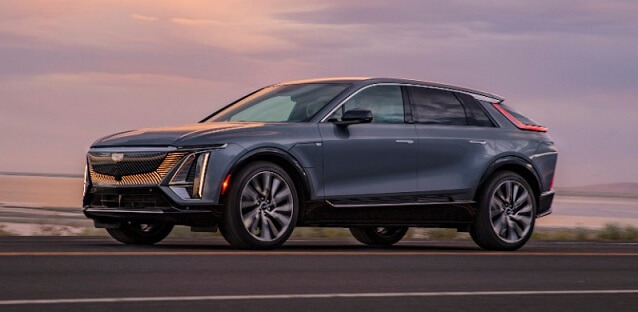Key specs
Cadillac LYRIQ (Crossover) LYRIQ 2022,2023,2024,2025,2026
What is the body type, Cadillac LYRIQ 100.4 kWh (340 Hp) 2022?
Crossover, 5 Doors, 5 Seats
How many cylinders, Cadillac LYRIQ 100.4 kWh (340 Hp) 2022?
Electric,
What is the drivetrain, Cadillac LYRIQ 100.4 kWh (340 Hp) 2022?
Rear wheel drive,
How long is this vehicle, Cadillac LYRIQ 100.4 kWh (340 Hp) 2022?
4996 mm
196.69 in.
How wide is the vehicle, Cadillac LYRIQ 100.4 kWh (340 Hp) 2022?
#N/D
What is the curb weight, Cadillac LYRIQ 100.4 kWh (340 Hp) 2022?
2545 kg
5610.76 lbs.
Cadillac LYRIQ (Crossover) LYRIQ 2022,2023,2024,2025,2026 Specs
General information
| Brand |
Cadillac |
| Model |
LYRIQ (Crossover) |
| Version |
LYRIQ |
| Engine version |
100.4 kWh (340 Hp) |
| Year production start |
2022 |
| Vehicle type |
Crossover |
| Curb weight kg -lbs total |
2545 kg
5610.76 lbs.
|
| Overall length mm - inch |
4996 mm
196.69 in.
|
| Doors |
5 |
Engine specs
| Engine position and orientation |
Rear axle, Transverse |
| Cylinders |
Electric |
| Fuel type |
Electricity |
| Powertrain architecture |
BEV (Electric Vehicle) |
| Electric motor power |
340 Hp
|
| Electric motor torque |
440 Nm 324.53 lb.-ft.
|
| Engine location |
Rear axle, Transverse
|
Transmission and Drive system
| Drive configuration |
Rear wheel drive
|
Brakes
| Front brakes |
Disc, 321 mm |
| Rear brakes |
Disc, 321 mm |
| Brake control |
Disc, 345 mm |
Steering
| Steering type |
Steering rack and pinion |
| Turning diameter m - ft |
12.1 m
39.7 ft.
|
Suspension
| Front suspension |
Independent multi-link |
| Rear suspension |
Independent multi-link |
Wheels & Tyres
| Wheels size |
265/50 R20; 275/40 R22
|
| Wheels rims |
20; 22 |
Passenger
| Passengers seats |
5 |
| Trunk space min liter | cu. Ft. |
793 l
28 cu. ft.
|
| Trunk space max liter | cu. Ft. |
1723 l
60.85 cu. ft.
|
Dimensions
| Overall length mm - inch |
4996 mm
196.69 in.
|
| Overall height mm -inch |
1623 mm
63.9 in.
|
| Wheelbase mm - inch |
3094 mm
121.81 in.
|
Weights
| Curb weight kg -lbs total |
2545 kg
5610.76 lbs.
|
Engine type
Electric
https://www.thecarspec.com/components/engine/electric

